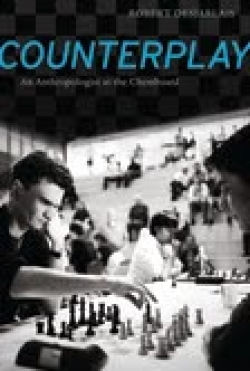Counterplay
An Anthropologist at the Chessboard
“Chess, like love, like music, has the power to make men happy,” said Siegbert Tarrasch, one of the many past masters we meet in Counterplay, by Robert Desjarlais. A tournament chess player and professor of anthropology at Sarah Lawrence College, his latest book studies amateurs and pros, casual players and addicts. Earlier work includes research on life and death in the Himalayas, and Shelter Blues, about the homeless in Boston.
Desjarlais wants to know what attracts people to the game and how it affects their lives. A participant-observer, he tells his personal story while introducing chess culture and vocabulary. World champions like Bobby Fischer and Gary Kasparov are discussed, as is the recent influx of women players.
Like many of life’s fascinations, chess can be a boon and a burden. Desjarlais calls it a “gymnasium for the mind,” a game of complexity and beauty that leaves nothing to chance. Think of it as two players wracking their brains to create a joint work of art. The planning and self-discipline required to play well are among the good habits to be learned by players of all ages. According to the author, chess at a normal pace induces calm, patience, focus, and, of course, self-reliance, humility, and enjoyment.
Desjarlais surveys the world of chess in human terms, as it is played in homes, clubs, tournaments, and on the Internet. He explains that computers haven’t spoiled the game as some predicted, but are clearly a benefit in analyzing openings and positions in high-level play; and he notes that tournament directors have to watch for contestants cheating with hidden electronics. His own feelings about the game range from enjoyment to frustration, obsession to disinterest, all of which he shares frankly.
The subject of chess boasts more books than any other game, but this one is special, crafted for the general reader as well as the aficionado. One need not be a player to enjoy and profit from this book, but just an hour or two learning the moves—from a friend or online—should make a difference. The book includes a glossary of terms, diagrams explaining chess notation, and an appendix on teaching chess. Like the game itself, Counterplay is an enjoyable mental exercise.
Reviewed by
E. James Lieberman
Disclosure: This article is not an endorsement, but a review. The publisher of this book provided free copies of the book to have their book reviewed by a professional reviewer. No fee was paid by the publisher for this review. Foreword Reviews only recommends books that we love. Foreword Magazine, Inc. is disclosing this in accordance with the Federal Trade Commission’s 16 CFR, Part 255.

